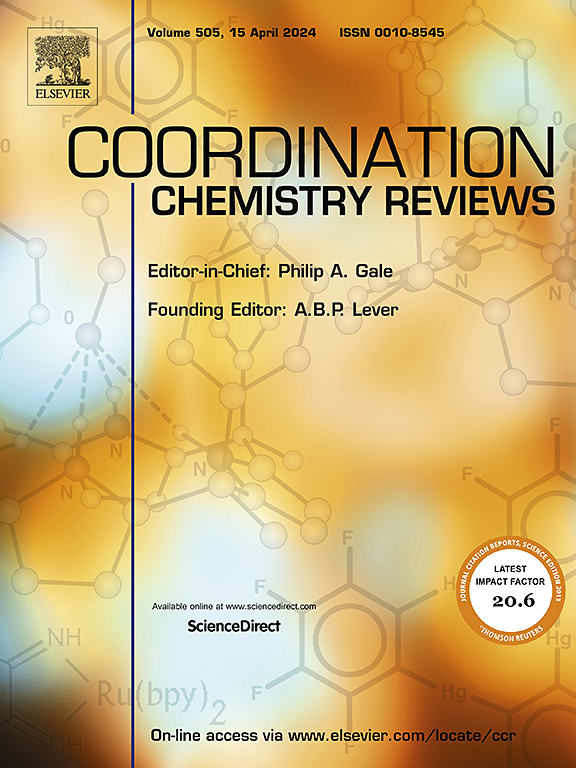Next-Generation Theragnostic Gold Nanoparticles: Sustainable Bioengineering Strategies for Enhanced Stability and Biocompatibility
IF 23.5
1区 化学
Q1 CHEMISTRY, INORGANIC & NUCLEAR
引用次数: 0
Abstract
The stability and dispersity of gold nanoparticles (AuNPs) against diverse biological, physicochemical, and physiological transformations while retaining biocompatibility are fundamental for their myriad utilization in various theragnostic applications. This comprehensive review provides a comprehensive analysis of the principles governing the colloidal stability of AuNPs and the factors influencing their physicochemical, chemical, and biological stability. Key parameters such as resistance to aggregation in aqueous and biological medium, stability under physiological pH and ionic conditions, and the impact of protein corona formation on nanoparticle functionality are illustrated in detail. Diverse surface engineering strategies that are employed for achieving ultra-stable AuNPs, including electrostatic and steric stabilization methods are explored. Attention is also given to the widely used polymers like polyethylene glycol, polyvinylpyrrolidone, polyethylenimine, poly(lactic-co-glycolic acid), and polydopamine, which have demonstrated significant efficacy in enhancing nanoparticle stability under physiological conditions along with their controversies and negative impacts. Alternatively, the emergence of safe bioconjugation strategies using proteins, peptides, and nucleic acids that offer promising pathways to improve biocompatibility and facilitate targeted applications are discussed. We also highlight the emerging sustainable approaches for AuNP stabilization using resilient biomolecules such as glycans, lipids, and plant-derived phytochemicals. Innovations like fish-scale-derived proteins and glycan-based coatings showcase the potential of biogenic methodologies to provide ultra-stable nanoparticles with minimal environmental impact. By advancing sustainable and innovative surface engineering strategies, this review underscores the potential for ultra-stable, biocompatible AuNPs to drive safer, more effective solutions in nanomedicine while reducing the ecological footprint of their production. The objective of this review is to systematically present both conventional and emerging strategies for stabilizing AuNPs, with a particular focus on sustainable, biocompatible, and high-performance approaches that support safer and more effective applications in nanomedicine. Unlike existing reviews that primarily focus on classical polymer-based stabilization or biomedical applications alone, this work uniquely integrates a critical evaluation of conventional polymers with a comprehensive overview of innovative, eco-friendly biogenic alternatives. It emphasizes the dual imperative of performance and sustainability, offering a forward-looking framework for designing next-generation AuNPs with minimal ecological impact.
新一代治疗性金纳米颗粒:增强稳定性和生物相容性的可持续生物工程策略
金纳米颗粒(AuNPs)在保持生物相容性的同时,对各种生物、物理化学和生理转化的稳定性和分散性是其在各种诊断应用中无数应用的基础。这篇综述全面分析了AuNPs胶体稳定性的原理以及影响其物理、化学和生物稳定性的因素。关键参数,如在水和生物介质中的抗聚集性,生理pH和离子条件下的稳定性,以及蛋白质电晕形成对纳米颗粒功能的影响。探索了用于实现超稳定aunp的各种表面工程策略,包括静电和空间稳定方法。此外,本文还对聚乙二醇、聚乙烯吡咯烷酮、聚乙烯亚胺、聚乳酸-羟基乙酸、聚多巴胺等广泛应用的聚合物进行了介绍,这些聚合物在生理条件下对纳米颗粒的稳定性有显著的增强作用,但也存在争议和负面影响。另外,本文还讨论了使用蛋白质、多肽和核酸的安全生物偶联策略的出现,这些策略为改善生物相容性和促进靶向应用提供了有希望的途径。我们还强调了使用弹性生物分子(如聚糖、脂质和植物源性植物化学物质)稳定AuNP的新兴可持续方法。鱼鳞衍生的蛋白质和基于聚糖的涂层等创新展示了生物源方法的潜力,可以提供对环境影响最小的超稳定纳米颗粒。通过推进可持续和创新的表面工程策略,本综述强调了超稳定、生物相容性aunp的潜力,以推动纳米医学中更安全、更有效的解决方案,同时减少其生产的生态足迹。本综述的目的是系统地介绍稳定aunp的传统和新兴策略,特别关注可持续的、生物相容性的和高性能的方法,这些方法支持纳米医学中更安全、更有效的应用。与现有的主要关注传统聚合物稳定或生物医学应用的评论不同,这项工作独特地将传统聚合物的关键评估与创新,生态友好的生物替代品的全面概述结合起来。它强调了性能和可持续性的双重要求,为设计具有最小生态影响的下一代aunp提供了前瞻性框架。
本文章由计算机程序翻译,如有差异,请以英文原文为准。
求助全文
约1分钟内获得全文
求助全文
来源期刊

Coordination Chemistry Reviews
化学-无机化学与核化学
CiteScore
34.30
自引率
5.30%
发文量
457
审稿时长
54 days
期刊介绍:
Coordination Chemistry Reviews offers rapid publication of review articles on current and significant topics in coordination chemistry, encompassing organometallic, supramolecular, theoretical, and bioinorganic chemistry. It also covers catalysis, materials chemistry, and metal-organic frameworks from a coordination chemistry perspective. Reviews summarize recent developments or discuss specific techniques, welcoming contributions from both established and emerging researchers.
The journal releases special issues on timely subjects, including those featuring contributions from specific regions or conferences. Occasional full-length book articles are also featured. Additionally, special volumes cover annual reviews of main group chemistry, transition metal group chemistry, and organometallic chemistry. These comprehensive reviews are vital resources for those engaged in coordination chemistry, further establishing Coordination Chemistry Reviews as a hub for insightful surveys in inorganic and physical inorganic chemistry.
 求助内容:
求助内容: 应助结果提醒方式:
应助结果提醒方式:


